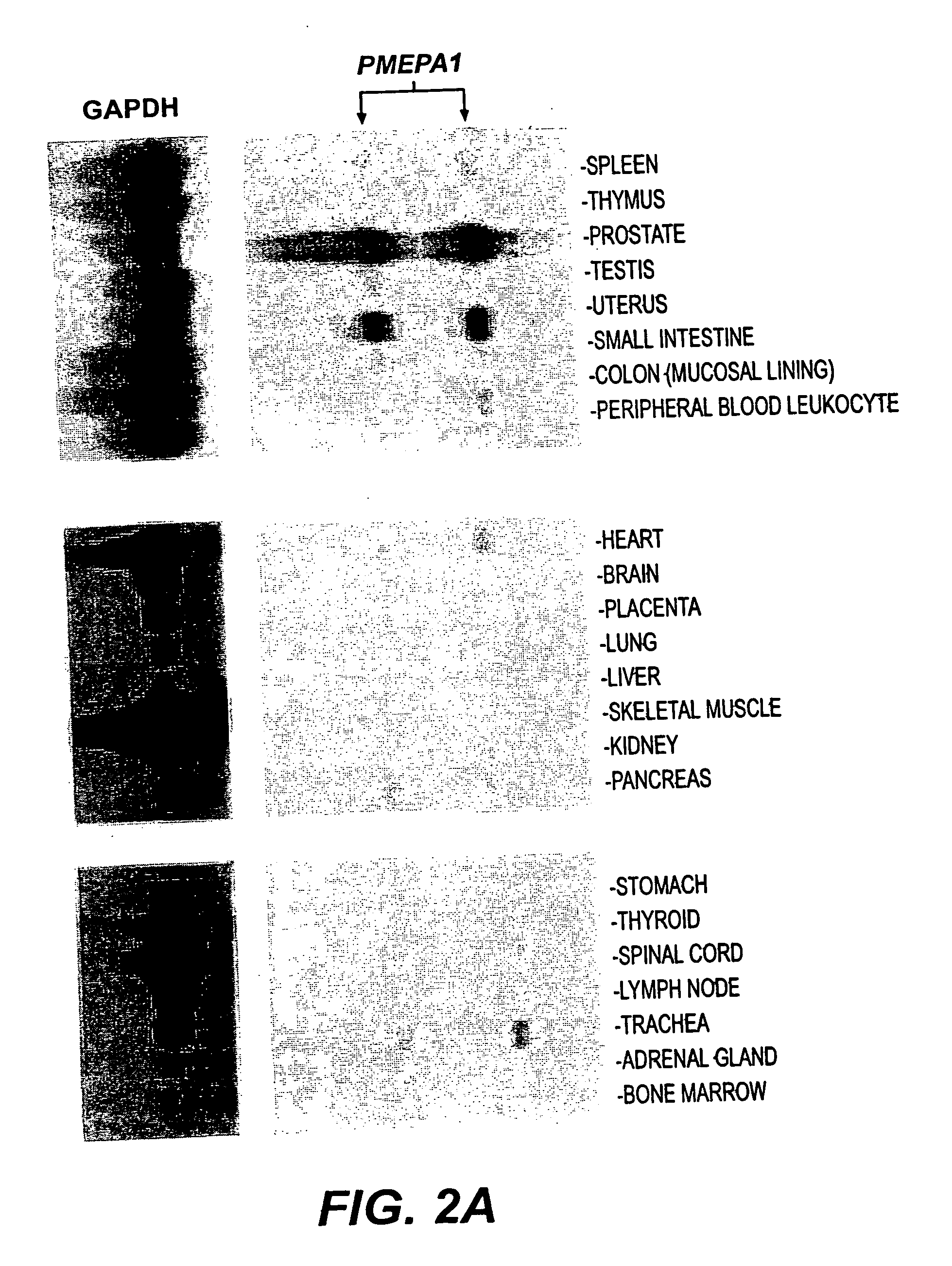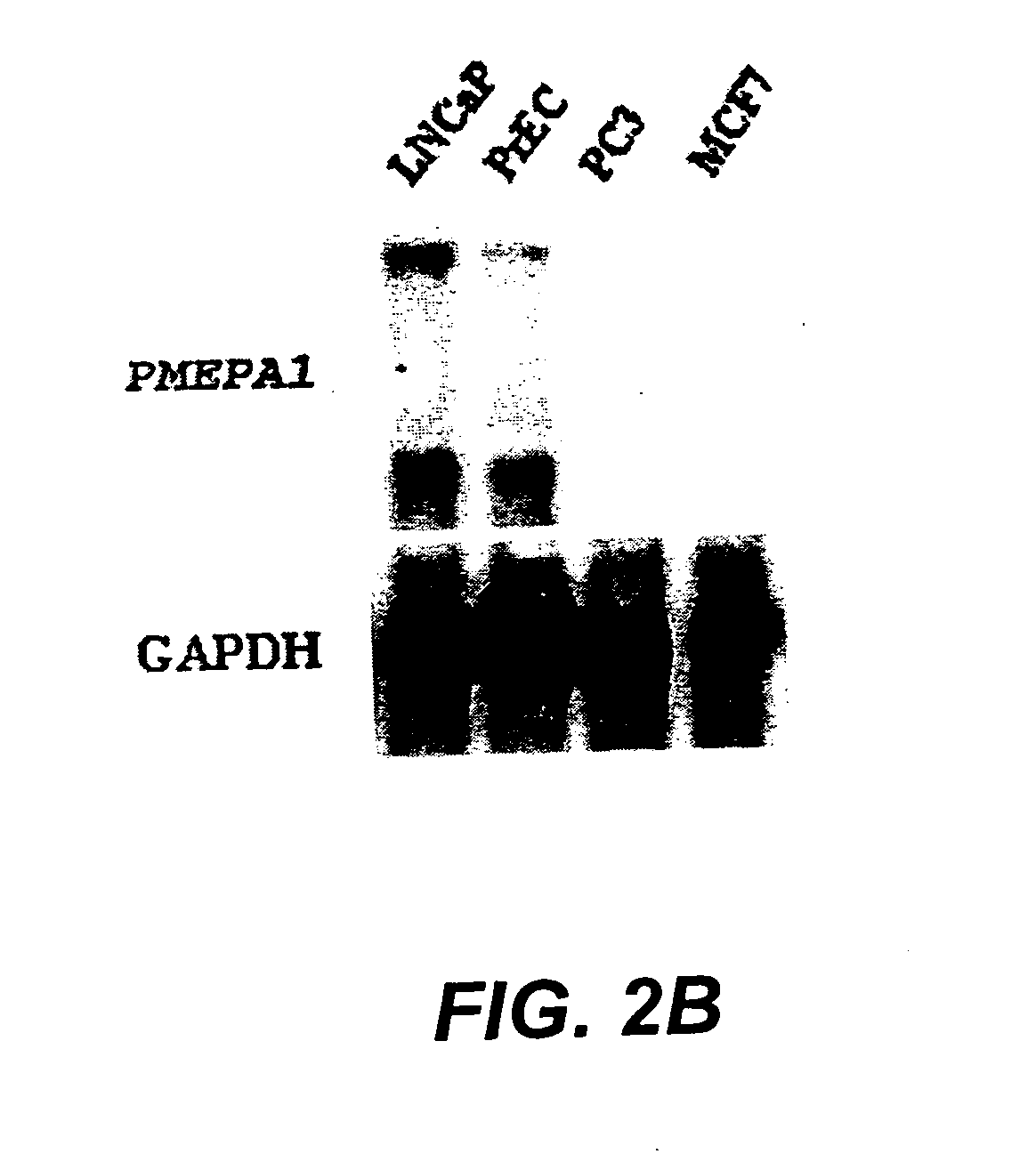Androgen-regulated PMEPA1 gene and polypeptides
a technology of pmepa1 and polypeptides, applied in the field of tumor suppressor genes, can solve the problems of still a very high false positive rate, difficult to predict, and limited use of each of these techniques, so as to reduce the cell growth inhibitory effect of pmepa1
- Summary
- Abstract
- Description
- Claims
- Application Information
AI Technical Summary
Benefits of technology
Problems solved by technology
Method used
Image
Examples
example 1
Cell Culture and Androgen Stimulation
[0131] LNCaP cells (American Type Culture Collection, Rockville, Md.) were used for SAGE analysis of ARGs. LNCaP cells were maintained in RPMI 1640 (Life Technologies, Inc., Gaithersburg, Md.) supplemented with 10% fetal bovine serum (FBS, Life Technologies, Inc., Gaithersburg, Md.) and experiments were performed on cells between passages 20 and 30. For the studies of androgen regulation, charcoal / dextran stripped androgen-free FBS (cFBS, Gemini Bio-Products, Inc., Calabasas, Calif.) was used. LNCAP cells were cultured first in RPMI 1640 with 10% cFBS for 5 days and then stimulated with 10-8 M of non-metabolizable androgen analog, R1881 (DUPONT, Boston, Mass.) for 24 hours. LNCaP cells identically treated but without R1881 treatment served as control. Cells were harvested at indicated time and polyA+ RNA was double-selected with Fast Track kit (Invitrogene). The quality of polyA+ was checked by Northern hybridization analysis.
example 2
SAGE Analysis
[0132] Two SAGE libraries (library LNCaP-C and library LNCaP-T) were generated according to the procedure described previously Velculescu et al. (30). Briefly, biotinylated oligo dT primed cDNA was prepared from five micrograms of polyA+ RNA from R1881 treated and control LNCaP cells and biotinylated cDNA was captured on strepravidin coated magnetic beads (Dynal Corporation, Mich.). cDNA bound to the magnetic beads were digested by NlaIII followed by ligation to synthetic linkers containing a site for anchoring enzyme, NlaIII and a site for tagging enzyme BsmF1. The restriction digestion of ligated products with BsmF1 resulted in the capture of 10-11 bp sequences termed as “tags” representing signature sequence of unique cDNAs. A multi-step strategy combining ligation, PCR, enzymatic digestion and gel purification yielded two tags linked together termed as “ditags.” Ditags were concatamerized, purified and cloned in plasmid pZero cloning vector (Invitrogen, Calif.). T...
example 3
Kinetics of Androgen Regulation ARGs Defined by SAGE Analysis
[0133] LNCaP cells were cultured in RPMI 1640 with 10% cFBS for 5 days, then stimulated with R1881 at 10-10, 10-8, and 10-6 M for 1, 3, 12, 24, 72, 120, 168, and 216 hours. LNCaP cells identically treated but without R1881 served as control. The cells were harvested at indicated time and polyA+ RNA was prepared as described as above. The polyA+ RNA was fractionated (2 μg / lane) by running through 1% formaldehyde-agarose gel and transferred to nylon membrane. The cDNA probes of several ARGs were labeled with 32P-dCTP by random priming (Stratagene Cloning Systems, La Jolla, Calif.). The nylon membranes were prehybridized for 2 hrs in hybridization buffer (10 mM Tris-HCl, pH 7.5, 10% Dextran sulfate, 40% Formamide, 5×SSC, 5× Denhardt's solution and 0.25 mg / ml salmon sperm DNA) and hybridized to the 32P labeled probes (1×106 cpmrn / ml) in the same buffer at 40° C. for 12-16 hrs. Blots were washed twice in 2×SSC / 0.1% SDS for 20...
PUM
| Property | Measurement | Unit |
|---|---|---|
| pH | aaaaa | aaaaa |
| temperature | aaaaa | aaaaa |
| pH | aaaaa | aaaaa |
Abstract
Description
Claims
Application Information
 Login to View More
Login to View More - R&D
- Intellectual Property
- Life Sciences
- Materials
- Tech Scout
- Unparalleled Data Quality
- Higher Quality Content
- 60% Fewer Hallucinations
Browse by: Latest US Patents, China's latest patents, Technical Efficacy Thesaurus, Application Domain, Technology Topic, Popular Technical Reports.
© 2025 PatSnap. All rights reserved.Legal|Privacy policy|Modern Slavery Act Transparency Statement|Sitemap|About US| Contact US: help@patsnap.com



